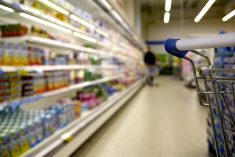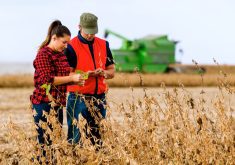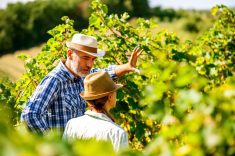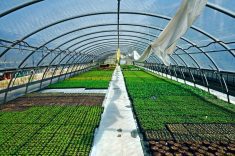As the sun set and the dust lingered over the freshly harvested fields, I gave thanks for the abundance.
Walking through the orchard with the sweet smell of ripening fruit and the warmth deep on my back, I gave thanks for the diversity.
Picking my way home, the sidewalk strewn with chestnuts and hazelnuts, I gave thanks for the way nature provides for us and for those creatures in the wild.
Read Also

The great food summit adventure
Alberta Farmer columnist Lee Hart attended the Food Leadership Summit in Calgary, where about 400 ag industry players gathered for the new annual conference.
Regardless of where my foot was planted, there was reason and motivation to be excited about the food grown in Canada. From the beef so plentiful on our prairies to the maple syrup harvested in the east, this is a country of great opportunity – and of loss.
The spillover from the combine on one farm could have fed several families for a year. The imperfect fruit left to rot on the ground would have made thousands of jars of preserves. The nuts not gathered could provide enough plant-based protein for several residents.
Can we do better?
Canada is a country facing massive food insecurity, with those in need nearing 18 per cent, rating us seventh in the world. This is simply shameful in a nation that boasts one fifth of the fresh water on earth and is one of the largest food commodity exporters in the world.
Our trade policy however, has overridden the domestic need for access to food, food education and regional infrastructure that allows us to add value at the local level, keeping food and people in communities. Our social economic policies deprive our constituents of equity between genders and classes. And our national infrastructure is fragmented, immature and in many areas broken.
Food access is not directly a farmer’s issue. The majority of food waste in Canada, 60 per cent, is from the consumer or “at the plate” as it is called. But farmers can still be influencers in food security discussions.
In 1857 artist Jean-Francois Millet painted “The Gleaners”, an oil of women picking up the residue stalks in a field post-harvest. I have a copy of this painting and it always moves me, for there is a humbleness to the scene.
Historically, gleaning was seen as a poor man’s option and landlords would often refuse gleaning. In many eras it was considered theft that church, state and private owners used for oppressive control. It is still looked down upon today.
In a stark contrast to the limitations to land and food access through the ages and the centralization of food, price, availability and cultural or class differences, we continue to live in a society of abundance. Farmers now produce more than enough to support the caloric needs of every human on earth three times a day.
When I read that a young couple safely fed and clothed themselves for a year from the city dumpsters, I knew that I underappreciated just how much of a throw-away society we are. The current resolution is found at retail with food rescues such as Canada’s Second Harvest who save from landfill the equivalent of 150,000 meals a day. Food Banks Canada fills the gap where government failed and is visited by 1.4 million Canadians each month. Charity has attempted to be the solution to food insecurity.
The solution, however, resides with technology at harvest and cultural change. It resides in active, long-term social policy that is reflective of the universal human right to nutritious, culturally appropriate food.
The future of economic stability is in the creation of infrastructure to support both regional value adding and interprovincial trade in food commodities and food.
Lack of education regarding the value of food production and food processing is needed for our next generation of leaders to appreciate it as a pillar in the health and wellness of a society. They simply do not know the opportunities within the food system. Knowledge is foundational.
Food insecurity is equally an income issue. Our embarrassing level of food insecurity is a cumulation of many factors including high rates of inflation, the high cost of housing, fuel, electricity and services that all congress into a shrinking middle class.
Farmers can be a force behind a nation that feeds their own first. Not only is food a need, it is a right.
I went home with my bags of gleaned fruit and again, I thought about the plight of the farmer – with limited processing to deliver food products and a consuming public unwilling to stop waste at the plate.
We must recognize that this is a food system where all the stakeholders intersect. Just as farmers can do better, so too can all levels of governments, academia, processors, retailers and consumers.
A society of privilege is a society of choice. Canadians are picky eaters and they waste a lot. Farmers can lead the charge by putting their faces out there, reminding consumers “I grew this for you” while lobbying for greater say in the final destination of what they grow and for more investment in local infrastructure in communities to add value to all food.
















